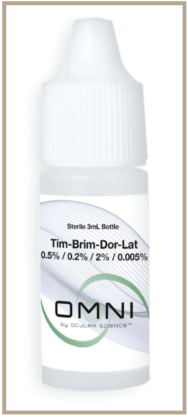A patient is given a prescription, and when he or she get to the pharmacy it is not included in their insurance formulary. Maybe the pharmacist calls the eye care provider’s office and the staff spends valuable time dealing with the issue, or maybe they switch the patient to a generic version of the drug. This is a scenario that seems to happen frequently, and it is often not the best option for the patient and is still overpriced. Ocular Science, an innovative biotech company based in Manhattan Beach, California, was created to offer an alternative: quality compounded products at a reasonable cost that come direct to your clinic or the patient’s home.
Ocular Science offers a lineup of compounded drugs that provide clinical equivalence to their branded counterparts, while eliminating the frustration and confusion that results when trying to adapt to the patient’s insurance formulary and budget. In addition, they are bringing patients and physicians the convenience of combination medications that have been available in other countries for years, but not in the United States.
Here is what a few ophthalmologists who prescribe Ocular Science’s products had to say.
Omni Drop for Cataract Surgery Patients
Nicole R. Fram, MD
The Omni drop (Ocular Science) for cataract surgery patients is a combination of prednisolone phosphate, gatifloxacin, and ketorolac. It is dosed four times a day for 2 weeks, and then two times a day for an additional 2 to 4 weeks following cataract surgery.

FIGURE. A combination of timolol, bimonodine, dorzolamide, and latanoprost.
Efficacy and safety being our top concerns, we conducted a head-to-head trial comparing the prednisolone phosphate/gatifloxacin/ketorolac drop to brand-name medications and normal practice patterns.1 This new drop performed extremely well with our patients. Primary outcomes were at least as equivalent—and in some cases better—than previous standard of care in regard to inflammation and pain control. Epithelial staining and macular thickness were measured as secondary outcomes and were equivalent to branded drops. There was a trend toward improvement in epithelial staining with the phosphate/gatifloxacin/ketorolac drop. In addition, patients in my practice overwhelmingly preferred the convenience and decreased cost of a single drop.
LASIK Combination Drop
Jonathan D. Solomon, MD
Access to a company or a pharmacy that has the ability to compound medications at a reasonable cost is beneficial to providers, the community, and patients. LASIK patients are paying out-of-pocket for an elective procedure with a certain goal in mind. The goal can only be reached by following proper post-procedure protocol, which can involve multiple ocular medications. This polydrug therapy in the post-procedure period leads to reduced compliance rates.2 When dealing with medications for premium surgeries and out-of-pocket elective procedures, compliance must be paramount. Combination drugs automatically improve compliance while the compounding of predinolone phosphate/gatifloxacin by Ocular Science can help manage the variable cost to patients often seen with commercial products.
In a shifting medical-legal environment where patients are considered clients, eye care providers must ensure they are providing the best service with superior outcomes, without the challenge of what may be perceived as hidden fees related to variable co-pays. From a patient satisfaction standpoint, I can tell you without hesitation that patients are much happier with these products and our new level of service.
Genesis: Treatment for Dry Eye Disease
Damien F. Goldberg, MD
Amniotic membranes have proven to be very effective in wound healing for a variety eye care conditions.3 Unfortunately, many of the key cytokines that prevent inflammation become lost in the processing technique for medical use. Ocular Science has innovated a way to preserve these active cytokines and now offers a new amniotic cytokine extract, ACE, (Genesis; Ocular Science) for the treatment of dry eye disease (DED).4
This is the first effective ACE for the treatment of DED. Cryopreserved amniotic eye drops contain more than 120 cytokines, growth factors and anti-inflammatory molecules to modulate and restore balance to the tear film. Key mediators include thrombospondin-1, WNT4, PGE2 and GDF11. Amniotic tissue has been shown to modulate wound healing by mitigating the inflammatory cascade.
As it pertains to DED, ACE has the potential to modulate corneal and conjunctival epithelial healing, as well as modulate inflammation.5 Processing of amniotic extract is critical as preservation of the key cytokines is essential to its efficacy. ACE can be safely stored in a home freezer while retaining its efficacy. The drop is used twice daily.
Dex-Moxi Injection: Getting the Medication Where It Needs To Be
Francis S. Mah, MD
Studies conducted in the United States and abroad have brought into question the efficacy of topical antibiotics following cataract surgery for prophylaxis of endophthalmitis.6,7 Ocular Science, among others, is providing an alternative to antibiotics in the form of an intracamaral injection of either moxifloxacin alone, or a combination product of dexamethasone and moxifloxacin. These drugs have been well-studied in terms of safety and efficacy, and have proven to be effective without provoking a steroid response in patients. In addition, the clear solution allows them to be injected directly into the anterior chamber.
There is also the added benefit of convenience for both for the patients and staff. Gone is the frustration of formulary coverage, expensive medications, and issues with patient compliance. While the cost of the injection must be covered by the surgery center, it is comforting to know that this technique is shown in the peer reviewed literature to be the best method of prophylaxis, while at the same time reducing the overall cost to the health care system.
Improving Compliance with Combination Glaucoma Drops
Nathan Radcliffe, MD
For most glaucoma patients, monotherapy will be sufficient. For that unlucky 5% to 10% of patients who require more than two drops, medication dosing can be very confusing. With generics on the landscape, patients are facing a constantly shifting paradigm every month as pharmacies switch manufacturers, resulting in changes to bottle color, shape, and appearance. It is already well known that compliance drops precipitously after the second agent is added. Once the patient is on three medications, not only does compliance fail, but confusion over correct dosing and correct adherence regimen becomes ubiquitous.2 Add to that generic prices that have quadrupled during the past 10 years and concerns about increasing amounts of preservatives damaging the ocular surface.
Ocular Science is eliminating these concerns by offering the most commonly prescribed glaucoma medications in a single bottle. The first combination includes timolol, bimonodine, and dorzolamide, while a second option adds to that latanoprost (Figure). Patients can take the triple combination drop twice per day, or for those who need maximum medical therapy, they can take the triple drop in the morning and the quadruple drop at night. This takes a complex medical regimen with four separate bottles and seven different applications a day, and simplifies it into a single morning and a single evening drop. There is also a fixed combination drop containing both latanoprost and timolol. The precipitous drop in cost, in addition to the simplified dosing, creates, in my opinion, a thrilling new option for our patients.
1. Fram N. Presented at the American Society of Cataract and Refractive Surgeons; May 5-9, 2017; Los Angeles, CA.
2. Blackwell B. Treatment adherence. Br J Psychiatry. 1976;129:513-31.
3. Tseng SCG. Amniotic membrane transplantation for ocular surface reconstruction. Bioscience Reports. 2001;21(4):481-489.
4. Steed DL, Trumpower C, Duffy D, et al. Amnion-derived cellular cytokine solution: a physiological combination of cytokines for wound healing. Eplasty. 2008;7;8:e18.
5. Lee MJ, Ko AY, Ko JH, et al. Mesenchymal stem/stromal cells protect the ocular surface by suppressing inflammation in an experimental dry eye. Mol Ther. 2015;23(1):139-146.
6. Herrinton LJ, Shorstein NH, Paschal JF, et al. Comparative effectiveness of antibiotic prophylaxis in cataract surgery.Ophthalmology. 2016;123(2):287-294.
7. Shorstein NH, Winthrop KL, Herrinton LJ. Decreased postoperative endophthalmitis rate after institution of intracameral antibiotics in a Northern California eye department J Cataract Refract Surg. 2013; 39:8-14.
Drs. Fram, Radcliffe, and Solomon serve as consultants to Ocular Science.
Drs. Goldberg and Mah are consultants and shareholders in Ocular Science.


